

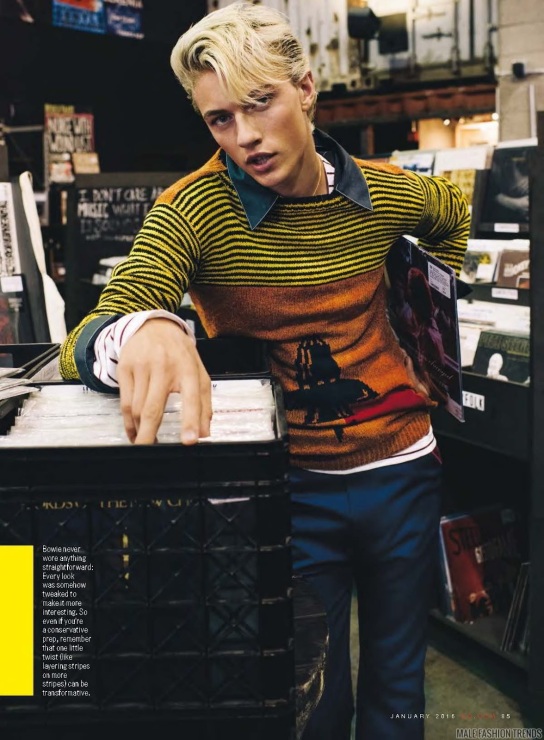



Model: Lucky Blue Smith
Photographer: Sebastian Kim
GQ, January 2016







Model: Lucky Blue Smith
Photographer: Sebastian Kim
GQ, January 2016
 Norman Rockwell preparing to enter a mosque
Norman Rockwell preparing to enter a mosque
 Omar Sharif in Lawrence of Arabia (David Lean, 1962). Sharif’s first English-language role was that of Sharif Ali in David Lean’s historical epic. This performance earned him a Best Supporting Actor Oscar nomination and a Golden Globe Award for Best Supporting Actor – Motion Picture, as well as a shared Golden Globe Award for New Star of the Year – Actor.
Omar Sharif in Lawrence of Arabia (David Lean, 1962). Sharif’s first English-language role was that of Sharif Ali in David Lean’s historical epic. This performance earned him a Best Supporting Actor Oscar nomination and a Golden Globe Award for Best Supporting Actor – Motion Picture, as well as a shared Golden Globe Award for New Star of the Year – Actor.
 Irish actor Peter O’Toole studying for his role as T.E. Lawrence. Photo by Dennis Oulds
Irish actor Peter O’Toole studying for his role as T.E. Lawrence. Photo by Dennis Oulds
 Lawrence of Arabia (David Lean, 1962)
Lawrence of Arabia (David Lean, 1962)
 Robert Pattinson as Lawrence of Arabia in Queen of the Desert (Werner Herzog, 2015), based on the life of British traveller, writer, archaeologist, explorer, cartographer and political officer Gertrude Bell.
Robert Pattinson as Lawrence of Arabia in Queen of the Desert (Werner Herzog, 2015), based on the life of British traveller, writer, archaeologist, explorer, cartographer and political officer Gertrude Bell.
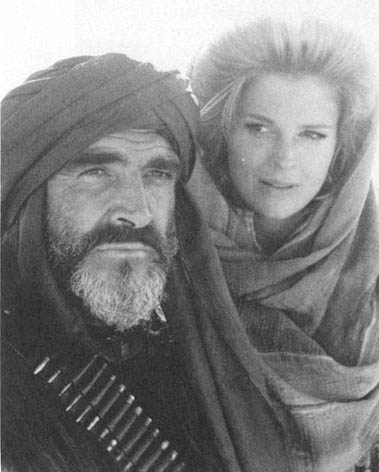
 Candice Bergen and Sean Connery in The Wind and the Lion (John Milius, 1975)
Candice Bergen and Sean Connery in The Wind and the Lion (John Milius, 1975)
 Virginia Woolf (far left) and her friends, dressed as Abyssinian dignataries, 1910
Virginia Woolf (far left) and her friends, dressed as Abyssinian dignataries, 1910
 Truman Capote in Tangier (Morocco)
Truman Capote in Tangier (Morocco)
 Yves Saint Laurent in Marrakesh
Yves Saint Laurent in Marrakesh

 Christian Louboutin purchased a villa near the Nile river
Christian Louboutin purchased a villa near the Nile river
 From left: Anne (Russia) in dress and hat, Nina Ricci. Blouse, Miguel Adrover. Natasha (former Yugoslavia) in bodice, Imitation of Christ. Blouse, Prada. Petticoat, What Comes Around Goes Around. Jeans, Levi’s. Headscarf, Dolce & Gabbana. Socks, Gaultier Paris. Liliana (Mexico) in jacket, Dolce & Gabbana. Stripped jeans, Christian Dior. Hair pieces, M.S. Schmalberg. Kae (Japan) in kimono Jean-Paul Gaultier. Dress, Salvatore Ferragamo. Aline (Japan and Brazil) in top and pants Gaultier Paris. Audrey (France) in dress Yves Saint Laurent Haute Couture. Stella (UK) in jacket Dolce & Gabbana. Tank Michael Stars. kilt, Gold Label by Vivienne Westwood. Carmen (Estonia) in dress Miu Miu. Alek (Sudan) in pants Giorgio Armani. Jewelry, Craft Caravan. Karolina (Czech Republic) in dress, Marc Jacobs.
From left: Anne (Russia) in dress and hat, Nina Ricci. Blouse, Miguel Adrover. Natasha (former Yugoslavia) in bodice, Imitation of Christ. Blouse, Prada. Petticoat, What Comes Around Goes Around. Jeans, Levi’s. Headscarf, Dolce & Gabbana. Socks, Gaultier Paris. Liliana (Mexico) in jacket, Dolce & Gabbana. Stripped jeans, Christian Dior. Hair pieces, M.S. Schmalberg. Kae (Japan) in kimono Jean-Paul Gaultier. Dress, Salvatore Ferragamo. Aline (Japan and Brazil) in top and pants Gaultier Paris. Audrey (France) in dress Yves Saint Laurent Haute Couture. Stella (UK) in jacket Dolce & Gabbana. Tank Michael Stars. kilt, Gold Label by Vivienne Westwood. Carmen (Estonia) in dress Miu Miu. Alek (Sudan) in pants Giorgio Armani. Jewelry, Craft Caravan. Karolina (Czech Republic) in dress, Marc Jacobs.
 From left: Lya (Ethiopia) in dress, Christian Dior Haute Couture. Anouck (Belgium) in jacket and skirt, Veronique Branquinho. Madelaine (Spain) in jacket and dress, Gaultier Paris. Sharon (Israel) in caftan, Missoni. Marcelle (Brazil) in bikini Tom Ford for Gucci. Headdress, Pau Brasil. Rohini (India) in skirt OMO Norma Kamali. Rings, Chanel Haute Couture. Bracelets, Erickson Beamon. Maggie (USA) in top OMO Norma Kamali. Miniskirt, Dolce & Gabbana. Mariacarla (Italy) in dress Dolce & Gabbana. Pin, J.M. Schmalberg. Mini (Sweden) in blouse, Dolce & Gabbana. Corset, OMO Norma Kamali. Skirt, Miguel Adrover. Boots, Prada.
From left: Lya (Ethiopia) in dress, Christian Dior Haute Couture. Anouck (Belgium) in jacket and skirt, Veronique Branquinho. Madelaine (Spain) in jacket and dress, Gaultier Paris. Sharon (Israel) in caftan, Missoni. Marcelle (Brazil) in bikini Tom Ford for Gucci. Headdress, Pau Brasil. Rohini (India) in skirt OMO Norma Kamali. Rings, Chanel Haute Couture. Bracelets, Erickson Beamon. Maggie (USA) in top OMO Norma Kamali. Miniskirt, Dolce & Gabbana. Mariacarla (Italy) in dress Dolce & Gabbana. Pin, J.M. Schmalberg. Mini (Sweden) in blouse, Dolce & Gabbana. Corset, OMO Norma Kamali. Skirt, Miguel Adrover. Boots, Prada.
Fashion editorial inspired by John Lennon‘s song. Photos by Patrick Demarchelier. Harper’s Bazaar, December 2001
“The Gucci woman – you know what she’s after. The Saint Laurent woman – she’s going to torture you a little bit. You might have sex, but she will drip a little hot wax on you first.”
Tom Ford
(on the difference between the Gucci and the YSL woman)
2001
 Yves Saint Laurent Rive Gauche and Gucci designs by Tom Ford. Photo by Sølve Sundsbø for Harper’s Bazaar, January 2004
Yves Saint Laurent Rive Gauche and Gucci designs by Tom Ford. Photo by Sølve Sundsbø for Harper’s Bazaar, January 2004
Photo credit: New York Times
For eight consecutive seasons, Stefano Pilati released a Yves Saint Laurent Manifesto, distributed across cities globally. Working with photographers Inez van Lamsweerde & Vinoodh Matadin, Pilati’s Manifesto is intended to ‘bring the brand back to the streets’.An innovative initiative, which continues the succession of revolutionary moves Mr Saint Laurent made: he was the first French couturier to release a ready-to-wear line.









 Daria Werbowy photographed by Inez van Lamsweerde & Vinoodh Matadin. YSL by Stefano Pilati Fall/Winter 2010-2011 collection.
Daria Werbowy photographed by Inez van Lamsweerde & Vinoodh Matadin. YSL by Stefano Pilati Fall/Winter 2010-2011 collection.
The YSL Manifesto is much more than an en masse distribution of the seasonal campaign shots. Staying true to the idea of a ‘manifesto’ – a public written declaration of the intentions, opinion, or motives of a leader – it is a powerful, multi-layered message which goes a long way to explain Pilati’s thinking and visual iconography for the season.
“I fell in love with the idea of manifestos and with the term itself, because the word ‘manifesto’ implied a sense of breaking through something while still being connected to and aware of how things are today. In terms of the format, I didn’t really relate to any historical manifestos I’ve seen because my medium is fashion… There is fashion photography in the manifesto so even the idea of showing the pictures larger than they appear in normal magazines was part of the act of manifesting. First of all you need to question whether it’s interesting or not to be political about fashion, or instead you wish to reinforce a message to people that is simply about looking good and projecting a positive energy about yourself. I was no longer interested in thinking of fashion in an elitist way. Everything I picked up from the manifestos in the past suggested that they were trying to create energy around an ideology that was considered, in its time, underground. So I thought for today I would offer another perspective of a luxury brand to a broad demographic that doesn’t necessarily relate to fashion in the way that a more privileged layer of people do. I wanted to create a wider influence for the message that was being sent from the catwalk, by taking imagery of a collection and giving it to people on environmentally friendly paper in the street without targeting a specific demographic. One of my visions for Saint Laurent is about giving back, so that even if you can’t afford it, you can still pick up the essence of the message, the elements of fashion that might be considered increasingly irrelevant but remain for me its main aspects: the silhouette, the way the clothes are cut, the fabrics, a special pattern. It’s to say – “These are my thoughts and this is my message – you can pick up something from this and do it yourself. The Yves Saint Laurent manifestos are against aggressively, against exclusivity, against classification, against isolation, against introversion, against always looking at oneself. This is what it comes to in the end. Fashion can give rise to all of these things and it shouldn’t, especially today.”
To watch Manifesto Edition VII (Fall/Winter 2010-2011 collection), please take a gander at The Genealogy of Style’s Facebook page: https://www.facebook.com/pages/The-Genealogy-of-Style/597542157001228?ref=hl
 Yves Saint Laurent, the then-new head of Maison Dior, surrounded by house models wearing his designs. Photo: Loomis Dean, 1958
Yves Saint Laurent, the then-new head of Maison Dior, surrounded by house models wearing his designs. Photo: Loomis Dean, 1958
Yves Saint Laurent was introduced to designer Christian Dior by Michel De Brunoff, the editor of French Vogue.
To start with, he was given mundane tasks to complete but after winning first prize in the International Wool Secretariat contest for his cocktail dress design in 1954, Yves Saint Laurent landed the job of Haute Couture designer when Dior died in 1957 at the age of 52. At the tender age of 21, he launched a spring collection for the fashion house and gained critical acclaim for his dresses as the head of the House of Dior.
In 1960, he was conscripted into the French Army. His spell in the service was short-lived however, and he was transferred into a French mental hospital suffering from stress, where he underwent psychiatric treatment, including electroshock therapy, for a nervous breakdown. He served in the military for just 20 days.
In 1962, in the wake of his nervous breakdown, Saint Laurent was released from Dior and started his own label, YSL, financed by his companion, Pierre Bergé.
 Monsieur Christian Dior and his gardener, date unknown
Monsieur Christian Dior and his gardener, date unknown
The story began in 1906 in the hills above Granville in Normandy within the gardens on the property where the Dior family had recently settled. Around the villa, Christian Dior‘s mother built a lush garden from the ground up combining rare species of plants. It was young Christian who created and designed the rose garden. Throughout his life, the rose remained his favourite flower. It was key motif in his fashions (featured in prints, embroidery, brocades, etc.) and an essential note in his fragrances. Furthermore, the very name of his childhood home – les Rhumbs – is also a subtle reference to the rose: it defines the cardinal divisions of space, which in French is called ‘la rose des vents’, or windrose. Therefore, the rose, which was so vital to the life and work of the designer, has also become essential to Dior Jewellery collections such as Rose Dior Bagatelle.
Ever since, each designer at Masion Dior (Yves Saint Laurent, Marc Bohan, Gianfranco Ferré, John Galliano and Raf Simons) had followed the tradition of including roses in the collections for this iconic French brand, whether in prints, accesories or even on a showstopping stage.
 Rose de France afternoon dress in taffeta with colored rose print, Spring-Summer 1956 Haute Couture collection, Ligne Flèche (Arrow Line)
Rose de France afternoon dress in taffeta with colored rose print, Spring-Summer 1956 Haute Couture collection, Ligne Flèche (Arrow Line)
 Pierre-Auguste Renoir’s Roses Mousseuses influenced the rose print
Pierre-Auguste Renoir’s Roses Mousseuses influenced the rose print
 Carmen Dell’Orefice wearing Dior by Yves Saint Laurent. Photo: Richard Avedon, 1957
Carmen Dell’Orefice wearing Dior by Yves Saint Laurent. Photo: Richard Avedon, 1957
 Madrileña Dress of floating pale gray faille, Dior by Marc Bohan. Alexandre of Paris coiffure. Photo by Richard Avedon for Harper’s Bazaar, December 1960
Madrileña Dress of floating pale gray faille, Dior by Marc Bohan. Alexandre of Paris coiffure. Photo by Richard Avedon for Harper’s Bazaar, December 1960
 Carmen Dell’Orefice at Folies Bergère
Carmen Dell’Orefice at Folies Bergère
 Carmen Dell’Orefice at Folies Bergère, wearing a lace cocktail ensemble designed by Yves Saint Laurent for Christian Dior, photos by Richard Avedon for Harper’s Bazaar, 1957
Carmen Dell’Orefice at Folies Bergère, wearing a lace cocktail ensemble designed by Yves Saint Laurent for Christian Dior, photos by Richard Avedon for Harper’s Bazaar, 1957
Carmen is a unisex given name that represents two names taken as one. Its first (and original) root is Italian and Spanish, used as a diminutive nickname for Carmel and Carmelo (respectively), from Hebrew karmel, “God’s vineyard.” The second (and more recent) origin is from Latin carmen, which means “song,” “tune,” or “poem” and is also the root of the English word charm.
As a Spanish given name, it is usually part of the devotional compound names María del Carmen, Nuestra Señora del Carmen (Our Lady of Carmen) or Virgen del Carmen (in English Our Lady of Mount Carmel), stemming from the tradition of the vision of Mary the mother of Jesus on 16 July 1251 by Simon Stock, head of the Carmelite order.
To read extra info about people related to this name (specifically Carmen Marc Valvo), please take a gander at The Genealogy of Style‘s Facebook page: https://www.facebook.com/pages/The-Genealogy-of-Style/597542157001228?ref=hl
 Stamped Lips, Andy Warhol, 1959
Stamped Lips, Andy Warhol, 1959
 Yves Saint Laurent Spring Summer 1971
Yves Saint Laurent Spring Summer 1971
 Lips print dress from Yves Saint Laurent Rive Gauche, Harpers & Queen, early April 1971. Model: Viviane Fauny. Photo: Helmut Newton
Lips print dress from Yves Saint Laurent Rive Gauche, Harpers & Queen, early April 1971. Model: Viviane Fauny. Photo: Helmut Newton
 Dresses Yves Saint Laurent, Vogue Italia, February 1971, Photo By Chris Von Wagenheim
Dresses Yves Saint Laurent, Vogue Italia, February 1971, Photo By Chris Von Wagenheim
 Zooey Deschanel for ELLE in Saint Laurent by Slimane Lip Print dress, Spring 2014
Zooey Deschanel for ELLE in Saint Laurent by Slimane Lip Print dress, Spring 2014
 Rihanna wearing the sequined one shoulder top, also by Slimane. Vogue, March 2014. Photo: David Sims
Rihanna wearing the sequined one shoulder top, also by Slimane. Vogue, March 2014. Photo: David Sims
 Kristen Stewart on the cover of Marie Claire UK, May 2014
Kristen Stewart on the cover of Marie Claire UK, May 2014
 Alice and Olivia, Resort Collection 2014
Alice and Olivia, Resort Collection 2014
 Prada Spring Summer 2000 ad campaign
Prada Spring Summer 2000 ad campaign
 Michelle Williams on the cover of ELLE, December 2011 wearing a Prada dress
Michelle Williams on the cover of ELLE, December 2011 wearing a Prada dress
The main piece of the Romanian national dress is the blouse, the term being only attributed to the blouse worn by women. It is actually a Romanian traditional blouse worn on festive days, which is made of white cloth, cotton, flax or raw silk tissue, adorned with beads and embroideries on the sleeves and the neckline. The technique of adorning this blouse was handed down from mother to daughter, a fact that preserved the tradition and taste from one generation to another. The patterns are stylized, geometrical or inspired from nature.
In the course of time, the finesse of the materials that were used, the chromatic harmony, but also the cut of the pieces of the Romanian national dress, which were woven, cut and embroidered by hand, were appreciated by Romania’s Queens Elisabeta and Marie, but also by the women aristocrats of the time, who were proud to wear the Romanian national dress at various times.
 The first Blouse Roumaine prototype is considered to be created starting the 6th century B.C in Cucuteni culture. The ancient piece was called “ie”. The name derived from Latin “tunicae linae” which means thin tunic.
The first Blouse Roumaine prototype is considered to be created starting the 6th century B.C in Cucuteni culture. The ancient piece was called “ie”. The name derived from Latin “tunicae linae” which means thin tunic.
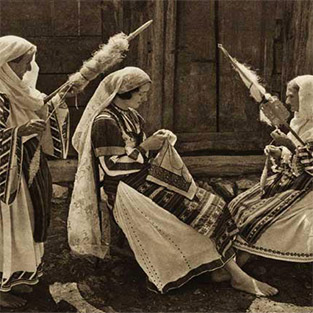 The sewing process of a blouse roumaine. The tradition of manufacturing the blouse is still kept among very rare artisans who are living on forgotten lands of ancient romanian villages.
The sewing process of a blouse roumaine. The tradition of manufacturing the blouse is still kept among very rare artisans who are living on forgotten lands of ancient romanian villages.
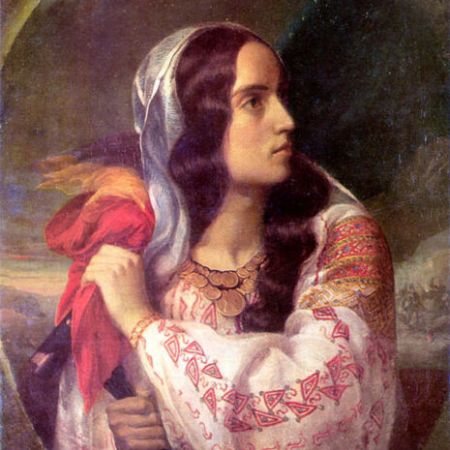 Revolutionary Romania (portrait of Maria Rosetti), Constantin Daniel Rosenthal, 1848
Revolutionary Romania (portrait of Maria Rosetti), Constantin Daniel Rosenthal, 1848
On the other hand, the Romanian blouse caught the artists’ eye and was immortalized by French painter Henri Matisse in several paintings, one of them, La Blouse roumaine (1940), being exhibited at the National Museum of Modern Art in Paris. A Romanian painter, Constantin Daniel Rosenthal, immortalized Maria Rosetti (the sister of artist Dante Gabriel Rossetti as well as William Michael Rossetti and Christina Georgina Rossetti) in Revolutionary Romania as wearing this kind of blouse and a head kerchief. The Romanian blouse also appears in the paintings made by Camil Ressu, Ion Theodorescu-Sion, Francisc Sirato, Nicolae Tonitza, Dumitru Ghiata, etc.

 Yves Saint Laurent, 1981 Collection
Yves Saint Laurent, 1981 Collection
 Yves Saint Laurent, Spring/Summer 1997-1998
Yves Saint Laurent, Spring/Summer 1997-1998
 Stefano Pilati for Yves Saint Laurent
Stefano Pilati for Yves Saint Laurent
 Adele wearing a Tom Ford blouse (spring summer 2011 collection)
Adele wearing a Tom Ford blouse (spring summer 2011 collection)
 Carolina Herrera Resort 2013 Collection
Carolina Herrera Resort 2013 Collection
The Romanian blouse was equally the source of inspiration for the creation of some fashion designers such as Yves Saint Laurent, who in 1981 had an entire collection titled ‘La Blouse roumaine,’ followed by Jean Paul Gaultier, Kenzo or Tom Ford, who interpreted again the traditional blouse he found in the region of Sibiu (central Romania), with black embroidery specific to that area, which appeared in the American issue of Vogue magazine in March 2012, worn by singer Adele. Then there were Oscar de la Renta, Agatha Ruiz de la Prada, Anna Sui or Philippe Guilet. Some of the Romanian fashion designers that took their inspiration from the Romanian national dress are Adrian Oianu, Dorin Negrau, Corina Vladescu and Ingrid Vlasov.
 Long evening dresses inspired by Henri Matisse-inspired evening gowns by Yves Saint Laurent, Autumn/Winter 1980-1981 collection. Black velvet and moire faille, multicolored satin applique leaves
Long evening dresses inspired by Henri Matisse-inspired evening gowns by Yves Saint Laurent, Autumn/Winter 1980-1981 collection. Black velvet and moire faille, multicolored satin applique leaves
 Yves Saint Laurent Couture Spring/Summer 1992 (Une Renaissance, based on Henri Matisse’s colors in Morocco)
Yves Saint Laurent Couture Spring/Summer 1992 (Une Renaissance, based on Henri Matisse’s colors in Morocco)
 Lady Gaga wearing a vintage Yves Saint Laurent blouse (Autumn/Winter 1980-1981 collection)
Lady Gaga wearing a vintage Yves Saint Laurent blouse (Autumn/Winter 1980-1981 collection)

 Vintage 1980’s Valentino Sheer Silk Georgette Jacket with Hood
Vintage 1980’s Valentino Sheer Silk Georgette Jacket with Hood

 Vivienne Westwood Nostalgia of Mud (Buffalo Girls) collection printed cotton jersey toga dress, Autumn/Winter, 1982-1983. World’s End labelled, the pink gown cut shorter at the front and with long train-like panel printed in dark brown with Matisse inspired motifs
Vivienne Westwood Nostalgia of Mud (Buffalo Girls) collection printed cotton jersey toga dress, Autumn/Winter, 1982-1983. World’s End labelled, the pink gown cut shorter at the front and with long train-like panel printed in dark brown with Matisse inspired motifs


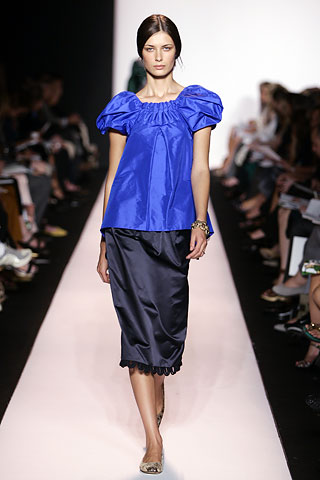
 Vera Wang Spring/Summer 2006 (inspired by the way Henri Matisse’s models dressed)
Vera Wang Spring/Summer 2006 (inspired by the way Henri Matisse’s models dressed)
 Carolina Herrera Spring-Summer 2010 Bridal collection. Wedding dress inspired by Matisse’s paper cut outs
Carolina Herrera Spring-Summer 2010 Bridal collection. Wedding dress inspired by Matisse’s paper cut outs
Roland Mouret Spring/Summer 2012 (inspired in part by the women close to Henri Matisse)
 Basso & Brooke Autumn/Winter 2012-2013
Basso & Brooke Autumn/Winter 2012-2013
 Printed leather trainers, also by Kenzo
Printed leather trainers, also by Kenzo


 Versace, Spring Summer 2012 Resort collection. Vacation dresses in a tropical print inspired by Matisse’s Bouquet
Versace, Spring Summer 2012 Resort collection. Vacation dresses in a tropical print inspired by Matisse’s Bouquet
Tata Naka Autumn/Winter 2014-2015 Pre Collection


 Yves Saint Laurent, Tribute to Vincent Van Gogh, haute couture collection, Spring-Summer 1988
Yves Saint Laurent, Tribute to Vincent Van Gogh, haute couture collection, Spring-Summer 1988
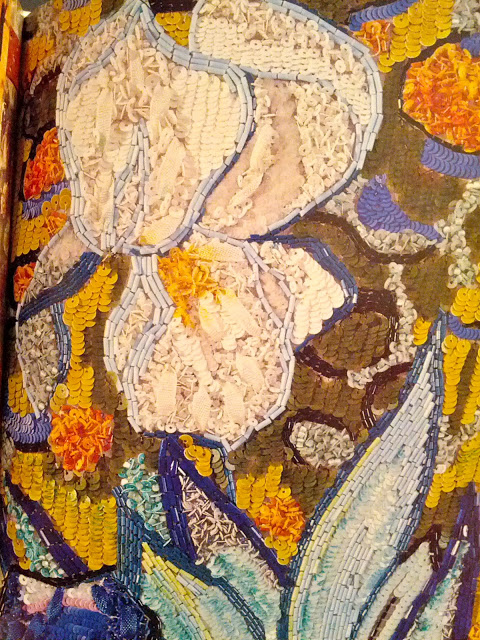 Detail of a jacket embroidered by François Lesage
Detail of a jacket embroidered by François Lesage

 Saint Laurent and Mr. Lesage recreated the irises and sunflowers of Van Gogh’s paintings
Saint Laurent and Mr. Lesage recreated the irises and sunflowers of Van Gogh’s paintings
Widely known for his use of watercolor, Vincent Van Gogh’s most famous artwork has been transformed into garments and adapted into fashion trends. Van Gogh’s paintings are not always clear and may even appear distorted in order to drag the 19th century art into current times. Although his work may not be directly printed on garments, designers tend to use his color palette in product design and production. Four of his famous creations included the Sunflowers still life series,Blossoming Almond Tree, Starry Night Over the Rhone, and Starry Night.
the sisters Kate and Laura Mulleavy from Rodarte, sent out a collection that was one part Sleeping Beauty and another part Vincent Van Gogh. They explained that they fell for the greens and purples of the 1959 animated Disney classic, and asked themselves who else uses colors like that. They found their answer in the Dutch postimpressionist painter beloved by millions.
Those sunflowers appear woven into elaborate Lyons brocades of the type favored by the great mid-century couturiers such as Pierre Balmain and Christian Dior, although the Mulleavys seem to have washed and treated them to deflate some of that sumptuousness. Those optimistic, life-affirming blooms also appear in delicate silk-floss embroideries, scattered over fragile tulle ruffles.
There is more mid- and late-century couture influence in some of the gala shapes: swathed fichu necklines and bodices erupting into buoyant skirts, for instance, and even a Reine Margot bodice or two that seems plucked from the Christian Lacroix archive. But the fertile and poetic Mulleavy imagination grafts these touches onto modernistic effects. Mediterranean skies are lit by a full moon, and a brilliant Milky Way is evoked in gleaming metallic brocades, crystals nestling in the folds of knits, and clunky heeled sandals in reflective-mirror silver. Meanwhile, ruched glove leather, and exaggerated layered peplums and winged sleeves suggest the princess in an Alex Raymond‘s Flash Gordon story.












 Rodarte, Spring-Summer 2012 Ready-to-Wear Collection
Rodarte, Spring-Summer 2012 Ready-to-Wear Collection
by Jade Reason
La vía del estilo
Art still has truth. Take refuge there.
Tales from Tinseltown...recording them now...I'll let you know when it's story time.
My Work My Art My Show - new school Sex and the City
All my words that are fit to print (and other's too!)
Making Life more Beautiful
Tulio Silva
Life, Leisure, Luxury
MYTHS AND HISTORIES OF A RELUCTANT BLOGGER
All my aimless thoughts, ideas, and ramblings, all packed into one site!
Meaning in Being. You be you.
Poetry, musings and sightings from where the country changes
Cooking is personalization.
Creativity is within us all